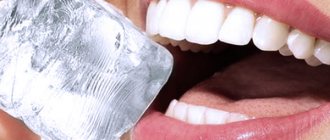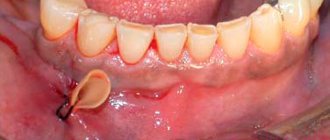Since childhood, our parents have taught us that eating a lot of sweets is bad for our teeth. Now, having become parents, we not only repeat the same thing to our children, but we also know from our own experience how unpleasant it is when teeth react to sweets. The pain can be sharp or barely noticeable, and usually, if you rinse your mouth, it goes away immediately. But is increased enamel sensitivity really safe, and are we taking this symptom too lightly? Let's find out!
What are the dangers of sweets?
Almost all sweet products: sugar, soda and syrups, jam, confectionery, sweet fruits (bananas, strawberries) are classified as simple carbohydrates. Such foods are broken down very quickly in the body and increase the amount of glucose in the blood, adding energy. This is effective before sports. When energy is not wasted, it is deposited in the form of fat reserves.
To break down and absorb simple carbohydrates, the body needs B vitamins and calcium. Teeth become a source for quickly obtaining the necessary macronutrients.
If the diet does not have enough vitamins and calcium, and a person consumes sweets excessively, then the expended reserves of necessary substances do not have time to be restored. This is how the process of internal tooth decay occurs. During this process, the enamel becomes thinner and caries develops.
Top 3 dangerous sweets
Dentists are unanimous in their opinion: all sugar-containing products are harmful to teeth. However, among these sweet enemies there are three main villains that can cause irreparable harm to crowns and gums. Meet:
- Princess Caramel . Yes, fresh lemon montpensiers and flavored peppermint candies are 58% sugar. That is, when you watch cartoons with your baby and enjoy countless caramels together, consider that you are eating sugar together with spoons. Moreover, lollipops take a long time to dissolve and, being in the mouth for a long time, activate the growth of bacteria that damage the enamel.
- Toffee's maids of honor . Kids love to enjoy delicate creamy toffees at any time of the day or night. However, such sweets stick to the teeth while chewing, and most importantly, they fill the interdental spaces with sugar. The sweet substance takes a long time to dissolve and provokes the growth of bacteria that are harmful to the enamel. By the way, it is toffee lovers who are most often diagnosed with caries in the spaces between their teeth.
- King Chocolate . Unfortunately, like caramel, chocolate and chocolate products consist of more than 50% sugar. And if dark chocolate is not so harmful, then children’s favorite milk and white sweets have a detrimental effect on teeth.
Sweet soda, kvass and cheap packaged juices are also harmful to children's teeth. These products also contain a significant dose of sugar.
As we have already said, sugar has a bad effect not only on the condition of your teeth. This sweet powder destroys both bones and the cardiovascular system, and also increases appetite and causes the release of insulin into the blood.
Favorable environment for bacteria
There are always bacteria in the mouth, even if you brush your teeth regularly. They do not react with meat products, most vegetables and fish. Such foods do not affect the condition of teeth.
Why do teeth react with sweets, and what happens when simple carbohydrates enter the body? Simple carbohydrates react with bacteria, resulting in the formation of organic acid in the oral cavity, which has a negative effect on the surface of the teeth. As a result of these processes, the enamel becomes thinner, destroyed and caries begins to develop.
Saliva contains special substances that can neutralize harmful organic acids. With the regular intake of sweets into the oral cavity in large quantities, the body is not able to fully protect tooth enamel.
Buns and cakes
If we are talking about baking, then there is only danger from nutritional science. Various rolls, pastries, cakes with different creams - protein, sour cream, butter - do not harm your teeth at all. The same principle works here as with chocolate: such sweets do not stay in the mouth for a long time, we chew them and again stimulate the washing of the teeth with saliva, followed by their mineralization. Therefore, this option can also be called harmless to human teeth.
So fickle! How to protect baby teeth from caries Read more
Harmful sweets
Dentists are convinced that any sweets have a negative effect on the tooth surface. However, some treats are extremely dangerous.
The following sweets cause maximum damage to teeth:
- Iris . All chewing candies stick to the surface of the teeth and become clogged in the interdental spaces. Because of this, the remains of such treats remain in the mouth for a long time. They cause the growth of pathogenic bacteria and the production of organic acid, which damages the enamel.
- Caramel . All kinds of candies, as well as creamy caramel, consist of a large amount of sugar (more than 50%). Such sweets are designed to be absorbed, which means they stay in the mouth for a long time and have a detrimental effect on the teeth.
- Chocolate . Chocolate products, like caramels, consist of 50% sugar. Therefore, the consumption of this kind of treats, especially in large quantities, is not recommended.
Dark chocolate causes the least damage to tooth enamel. This product contains less sugar and is enriched with tannins, which disinfect the oral cavity and slow down the growth of pathogenic microorganisms.
How to reduce the effect of sugar on your teeth?
When consuming sweets, you can use a number of recommendations to reduce the harmful effects on enamel. These include:
- Drink enough fluids (to ensure that bacteria and sugar residues are washed away).
- Eating sweets after the main meal (when a large amount of saliva remains in the mouth).
- Refusal of frequent snacks, especially sweets (the more often you eat, the more bacteria will form, especially if you eat sweet foods).
- Daily careful personal hygiene (you need to not just brush your teeth twice a day, but also follow all the rules: brush for at least 2 minutes, don’t forget about your tongue, choose the right brush, toothpaste, use dental floss, mouthwash).
To avoid negative consequences, do not forget about preventive visits to the dentist, especially if you like to eat sweets.
Natural pests
Not only sucrose, which is part of chocolate and sweets, but also fructose, which is found in some fruits and berries, has a harmful effect on tooth enamel.
Dentists recommend minimizing the consumption of the following treats:
- Dried fruits . Sweet prunes and raisins contain a large amount of fructose. This substance affects tooth enamel in almost the same way as sucrose. Dried fruits have an inherent viscosity, not unlike toffees. This means that they can also get clogged between the teeth and remain in the oral cavity for a long time.
- Candied fruits . Pieces of dried mango, kiwi and pineapple attract attention with their “naturalness”. However, candied fruits are sprinkled with sugar and sometimes tinted with dyes, which makes them little different from ordinary sweets.
- Sour fruits . Citrus fruits (oranges, lemons) cause significant damage to teeth. They contain a large amount of fruit acids, which can corrode enamel in the same way as candy.
All clear. I won't eat sweets, is that enough?
No, unfortunately, this is not at all enough.
Nowadays, the concept of “added sugar” has appeared; it is found in products where it should not normally be present. Sugar appears in kindergarten borscht and vegetable stews, if you check the technological map, and is found in store-bought sauces, semi-finished products, bread, packaged juices, baby formula and yoghurts. Bread can be as varied as you like with sprouted grains of all kinds of crops, but almost every “brick”, every “loaf” contains about 4 tablespoons of sugar. The inscription “sugar-free” on the label is currently even more alarming than the honest sugar in the composition.
Sugar has many synonyms in the food industry: molasses, molasses, grape sugar, coconut sugar, brown rice syrup, glucose-fructose syrup, maltodextrin, honey, invert sugar, agave syrup, Jerusalem artichoke syrup - about 60 names in total.
When we eat a cereal bar, we first get a dose of broken down carbohydrates and only then the potential benefits of a piece of fruit or traces of grains.
Russian “Japanese” cuisine can be distinguished separately - to prepare rice for sushi, rice vinegar and sugar, ginger and Wasabi seasoning, Teriyaki and Blue Cheese sauces, which also contain sugar, are used. Instead of immodest fish and rice, it’s more honest to eat a chocolate bar.
It is the added sugar that poses the biggest problem - while we can consciously give up obviously sugary foods, such as candy and baked goods, then the added sugar is hiding in places we didn’t expect.
How to minimize harm from sweets
The best option is to completely give up sweets. But for most adults, and especially for children, this option is unacceptable. According to statistics, there are very few people who are absolutely indifferent to sweets.
There are some recommendations for proper consumption of sweets, following which helps reduce the negative impact of sweets on teeth.
- The right treats . Experts recommend eating soft, but not sticky treats. For example, instead of toffees and marshmallows, it is better to choose cream cakes. They do not stick to tooth enamel and are easily removed after a couple of sips of drink.
- Sweets after meals . This rule is often voiced by parents to their children. After all, by eating sweets, you can “kill” your appetite. Dentists state this rule a little differently. During a meal (eating soup or side dish), a process of abundant saliva production occurs in the oral cavity. It is in this environment that sweets should be placed in order to neutralize organic acid as much as possible.
- Diet . Eating sweets should not be spread out over the whole day. It is recommended to eat the entire portion at one time. Constant snacking on sweets, cookies and chocolate regularly feeds bacteria. Such eating of sweets can lead to rapid destruction of enamel and the development of caries.
- Maintaining hygiene . From early childhood, you need to teach your child to brush their teeth. To reduce the negative impact of sweets on your teeth, you need to rinse your mouth after eating it. If this is not possible, then rinsing can be replaced by short-term use of chewing gum.
Interesting facts and myths about dental caries
Nine times out of ten, the average dentist who sees patients treats dental caries. And this is not surprising, since caries is the most common dental disease, which in most cases leads to complications and contributes to the development of other, more serious diseases. In this article we will explore interesting facts about caries, and also dispel a number of myths that surround this dental problem.
The cause of caries development is sugar/sweet/flour
It is generally accepted that consuming an impressive amount of sweet and starchy foods leads to the development of dental caries. In fact, the root cause is somewhat different: caries affects the teeth in the case of increased acidity of the oral cavity, which is provoked by bacteria. These same bacteria feed on carbohydrates, the content of which is higher in sweet and sugar-containing foods than in others.
Carbohydrates are found not only in sugar, but also in safer foods, including vegetables, fruits, fish and berries.
If you do not pay due attention to oral hygiene (especially after eating), the concentration of bacteria increases, which leads to the development of caries and the appearance of other, even more serious dental diseases.
Acidic foods provoke the development of caries
This is the honest truth, however, the mechanism of action is somewhat more complicated than it might seem at first glance. There is no direct effect of acids on caries; however, acidic foods destroy enamel, which is a kind of protective shell that protects teeth from the influence of negative factors.
If this shell disappears, there is a direct effect of irritants on human teeth, including various acids.
This is why frequent consumption of certain foods (such as lemons or acidic soda), especially if you have enamel problems, can lead to the development of tooth decay.
Childhood caries is more common than adult caries
For some reason, it is generally accepted that in childhood people are more likely to encounter caries, however, this is just a myth that we will hasten to destroy. There are many reasons why dental damage can occur in children (for example, frequent consumption of sweets, improper and untimely oral hygiene), however, these same reasons are also relevant for adults. Moreover, to the standard problems, new ones are added - age-related ones (including digestive problems, loss of part of the teeth, malocclusion, bad habits and poor diet).
Aspirin applied to the tooth helps soothe toothache due to caries.
This is also a very popular myth, which we have already discussed once. It should be noted right away that aspirin (like other painkillers) only works after oral administration. Moreover, the same aspirin can even worsen the situation if used incorrectly: it is quite possible to get a burn to the mucous membrane, since some painkillers contain acids.
Any fillings need to be changed over time
It is generally accepted that none of the materials from which modern fillings are made has the ultimate strength that allows a person to use the same filling all his life after treatment of dental caries in Kirov.
Of course, a filling can fall out, chip or sag, however, very often there are cases when a well-installed filling serves a person for a lifetime.
This depends not only on the material, but also on the professionalism of the dentist, as well as on following the rules of dental care. By maintaining oral hygiene, taking care of your bite and eating right, you can fully expect that the filling will last for decades after dental treatment.
If caries appears, a person will immediately know about it
Pain, discomfort, darkening of the tooth are obvious signs of caries, visible to the naked eye. However, all these symptoms appear already at an advanced stage of the disease, when treatment requires more time, effort and, accordingly, money.
At the initial stages of the disease, dental caries in Kirov is absolutely invisible. As a rule, it is just a small dot, a crack in the enamel or a small stain.
Diagnosis is carried out exclusively in the dentist’s chair, who, with the help of his experience and knowledge, will be able to identify caries at a very early stage, when minimal dental intervention is required.
Most often, caries occurs between teeth.
This is an absolutely false conclusion, since any part of the tooth is susceptible to caries. There is even cervical caries that affects the base - this type is especially dangerous, because sooner or later the disease can affect the root, which will cause tooth loss.
Particular attention should be paid to cleaning hard-to-reach places - as a rule, this is where pathogenic bacteria accumulate, the activity of which causes caries.
Choose a brush wisely, do not forget to brush your teeth thoroughly in the morning and evening, use dental floss, and visit the dentist every six months. All these simple measures are the most effective in preventing caries. This is where the rule works best: the best way to solve a problem is to prevent it. Well, or early detection, which is also a worthy option!
Increased tooth sensitivity - an indicator of caries?
Do your teeth react to heat, cold, sweet, sour or salty? This does not mean at all that you have caries, because increased tooth sensitivity is a completely independent problem that may not be accompanied by the presence of other diseases.
However, in any case, you should consult a dentist, since tooth sensitivity can also occur due to other dental diseases.
Only an experienced dentist will conduct a high-quality examination and identify the cause of the painful reaction of teeth to irritants. And based on this, he will prescribe treatment/prevention, and also give competent recommendations.
There is no need to worry about caries in baby teeth.
In practice, the opposite is true: caries of baby teeth is just as dangerous as caries of permanent teeth. Some parents do not consider it necessary to spend time and money on treating their children’s unstable teeth, they say, these teeth will soon fall out anyway. In fact, failure to treat caries in baby teeth can lead to serious consequences. This includes tooth loss, the development of an inflammatory process, an abscess, and even the possibility of damage to a permanent tooth, which can be affected by an existing infection. It is worth remembering that every tooth needs attention and proper treatment. An exception can be considered, perhaps, wisdom teeth (eights) - they, as a rule, are not treated, but are immediately removed.
If you have dental caries in Kirov or are planning to undergo a routine examination by an experienced dentist, we invite you to Doctor Efremov’s Dentistry. Sign up for a consultation and get answers to all your questions! Information by phone: 8 (8332) 255-717. Be healthy and take care of the beauty of your smile!
What to replace unhealthy sweets with
Not all sweets are harmful to the body. Some treats can be beneficial. Dentists advise replacing harmful toffees and caramels with the following products:
- Honey _ It is a natural product rich in glucose and fructose. However, honey also contains a large amount of useful substances, vitamins, amino acids and minerals.
- Nuts . Most nuts combined with honey can replace any candy. Unlike confectionery sweets, nuts saturate the body with protein.
- Berries and fruits . Healthy alternatives to candy include pears, apples, raspberries or cherries.
- Dairy desserts . Natural yogurt with berries or cottage cheese with fruits also have a sweet taste. At the same time, dairy products are rich in vitamins and calcium.
Before you eat another piece of delicacy, you need to remember that it can not only hit your figure, but also harm your smile.
Forgot about fructose. How are things going with her?
With fructose, everything is ambiguous.
Fructose, in fact, is not particularly needed by our body - practically no cells can absorb it in its pure form, so the liver converts fructose into glucose. This process uses enzymes that we don't have much of, so much of the fructose is immediately converted into fat. Let's imagine that by eating a regular cookie, we can burn off the resulting glucose by exercising while it circulates in the blood and has not turned into fat. This “trick” will not work with fructose-containing cookies.
Fructose is processed without the participation of insulin, but there are still more disadvantages in this situation: eating disorders, a very delayed feeling of satiety, and again metabolic syndrome, one of the signs of which is insulin resistance.
With fruits it's different. In them, fructose is bound to fiber, which slows down its release, and it is also extremely difficult to eat enough fruit to get a dose of sugar equivalent to a chocolate bar.











